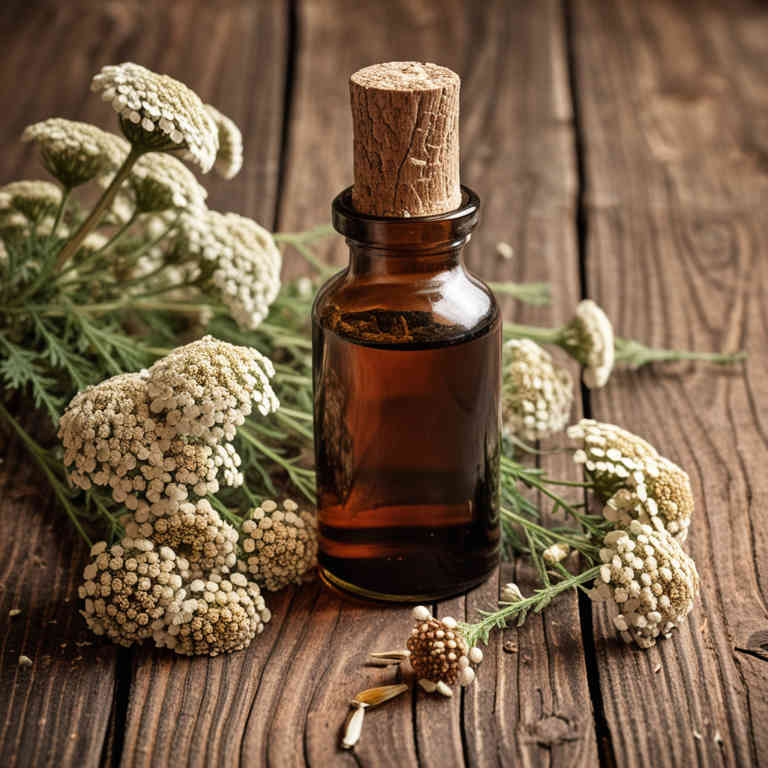Achillea millefolium tincture for medicinal use

Achillea millefolium tincture is a preparation made from the dried flowers of the yarrow plant, which is known for its medicinal properties.
It is commonly used in herbalism to support the circulatory system and reduce inflammation. This tincture is often taken internally to help with digestive issues and menstrual discomfort. It may also be applied externally to promote wound healing and reduce skin irritations.
Due to its potent nature, it is typically used in small doses under the guidance of a qualified herbalist.
Uses
Achillea millefolium tincture has been used to treat wounds, inflammation, and digestive issues for centuries.
Historically, it was revered by ancient Greeks and Romans for its healing properties, with the name "Achillea" derived from the legendary warrior Achilles, who supposedly used it to treat his soldiers' injuries. In traditional herbal medicine, it was also used to alleviate menstrual cramps and as a remedy for respiratory conditions. Modern research suggests it may have anti-inflammatory, antimicrobial, and antioxidant properties, supporting its use in contemporary herbal practices.
Today, it is commonly used in natural medicine to support skin health, reduce inflammation, and aid digestion.
Benefits
Achillea millefolium tincture has health benefits such as anti-inflammatory, antioxidant, and antimicrobial properties.
It is traditionally used to support wound healing and reduce inflammation in the body. This preparation may also help alleviate symptoms of digestive issues and menstrual discomfort. Its high concentration of compounds like flavonoids and sesquiterpene lactones contributes to its therapeutic effects.
Overall, Achillea millefolium tincture is valued for its potential to promote overall wellness and support various health conditions.
Constituents
Achillea millefolium tincture active constituents include compounds such as sesquiterpene lactones, flavonoids, phenolic acids, and volatile oils.
These components contribute to its anti-inflammatory, antimicrobial, and antioxidant properties. The sesquiterpene lactones are particularly noted for their ability to support wound healing and reduce inflammation. Flavonoids help in protecting cells from oxidative stress, while phenolic acids contribute to the overall therapeutic effects.
This tincture is commonly used to support digestive health, reduce menstrual discomfort, and promote skin healing.
Preparation
To make Achillea millefolium tincture, begin by gathering fresh or dried yarrow (Achillea millefolium) leaves and flowers.
Wash the plant material thoroughly and chop it into small pieces to increase surface area for extraction. Place the chopped plant in a clean glass jar and pour high-proof alcohol, such as vodka or grain alcohol, over it until the herbs are fully submerged. Seal the jar and let it sit in a dark, cool place for 4 to 6 weeks, shaking it occasionally to ensure even extraction.
After the steeping period, strain the liquid through a fine mesh strainer or cheesecloth to separate the tincture from the plant material, then store it in a dark glass bottle away from light.
Side Effects
Achillea millefolium tincture may lead to gastrointestinal discomfort, including nausea, vomiting, and diarrhea, especially with high doses.
It can also cause allergic reactions in individuals sensitive to plants in the Asteraceae family, such as ragweed. Long-term use may result in liver damage, particularly in people with pre-existing liver conditions. The tincture may interact with certain medications, including blood thinners and anticonvulsants, increasing the risk of adverse effects.
It is important to consult a healthcare professional before using this preparation, especially for prolonged periods or in combination with other treatments.